Celtic Religion
Dwarf, Elf, Troll and Pixie Trivia. There are legends, mythology and stories that encircle the globe about “little people”, a race and culture of impish, mischievous beings that have been encountered by various adventurers and people.
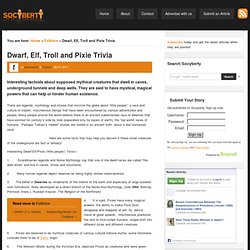
Many people around the world believe there is an ancient subterranean race of dwarves that have existed for century’s side by side (separated only by layers of earth), the ‘top world’ races of humans. Perhaps Tolkien’s ‘Hobbit” stories are rooted in an ancient truth, about a real humanoid race! Here are some facts that may help you discern if these small creatures of the underground are fact or fantasy! Interesting Dwarf/Elf/Pixie (‘little people’) Trivia— 1. 2.
Celtic Folklore. Sacred-texts home Legends and Sagas EnglandBuy CD-ROM Buy Books about Celtic Folklore Ireland Wales Scotland Brittany Cornwall Manx Fairies General Links.

The religious beliefs and practices of the ancient Celts. Druids and the Celtic Religion - Iron Age Celts for Kids. The Celts believed that demons and spirits were everywhere.
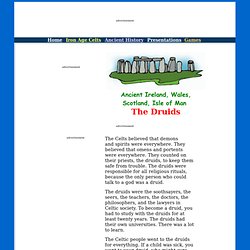
They believed that omens and portents were everywhere. They counted on their priests, the druids, to keep them safe from trouble. The druids were responsible for all religious rituals, because the only person who could talk to a god was a druid.
Celtic Mythology and Celtic Religion. When we consider ancient Celtic myths and Celtic legends, we are confronted with two rather conflicting mental images.
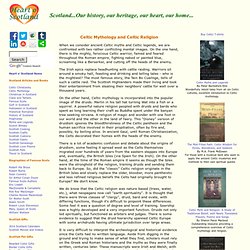
On the one hand, there is the mighty, ferocious Celtic warrior, famed and feared throughout the Roman empire, fighting naked or painted blue, screaming like a Berserker, and cutting off the heads of the enemy. The Irish epics replace headhunting with cattle raiding. Warriors sit around a smoky hall, feasting and drinking and telling tales - who is the mightiest? The most famous story, the Tain Bo Cuailnge, tells of such a cattle raid. The Scottish Highlanders made their living and took their entertainment from stealing their neighbors' cattle for well over a thousand years. On the other hand, Celtic mythology is incorporated into the popular image of the druids. We do know that the Celtic religion was nature based (trees, water, etc.), what neopagans now call "earth spirituality".
Celtic_religion. Celtic Gods and Goddesses - A List of Major Celtic Gods and Goddesses. The Druid priests of the Celts did not write down the stories of their gods and goddesses, but instead transmitted them orally, so our knowledge of the early Celtic deities is limited.
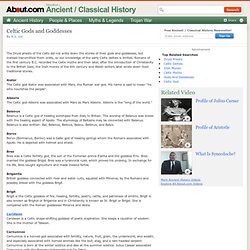
Romans of the first century B.C. recorded the Celtic myths and then later, after the introduction of Christianity to the British Isles, the Irish monks of the 6th century and Welsh writers later wrote down their traditional stories. Alator The Celtic god Alator was associated with Mars, the Roman war god. His name is said to mean "he who nourishes the people". Albiorix The Celtic god Albiorix was associated with Mars as Mars Albiorix. Belenus Belenus is a Celtic god of healing worshiped from Italy to Britain.
Borvo Borvo (Bormanus, Bormo) was a Gallic god of healing springs whom the Romans associated with Apollo. Bres. CELTIC HISTORY; BRIEFLY...
"The Celts were a southern European people of Indo-Aryan origin who first surfaced in Bohemia and travelled west in search of the home of the sun.

Science has recently established their basic blood group as 'O', in keeping with their modern descendants, which designates them as a seperate race from the aboriginals of the sourthern Indian subcontinent, where the 'B' blood group perdominates. History tells us that there were two main Celtic groups, one of which is referred to as the 'lowland Celts' who hailed from the region of the Danube. These people left their native pastures around 1200 BC and slowly made their way across Europe, founding the lake dwellings in Switzerland, the Danube valley and Ireland.
The Religion of the Ancient Celts: Title Page. Sacred Texts Legends and Sagas Celtic Index Next (b. 1868, d. 1950) T.
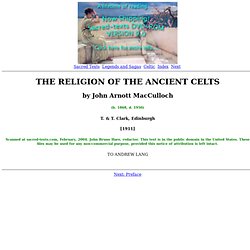
& T. Clark, Edinburgh Scanned at sacred-texts.com, February, 2004. John Bruno Hare, redactor. Next: Preface. Faeries. Fairy comes from the Old French word faerie.
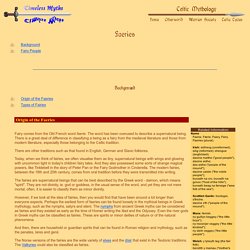
The word has been overused to describe a supernatural being. There is a great deal of difference in classifying a being as a fairy from the medieval literature and those from modern literature, especially those belonging to the Celtic tradition. There are other traditions such as that found in English, German and Slavic folklores. Today, when we think of fairies, we often visualise them as tiny, supernatural beings with wings and glowing with uncommon light in today's children fairy tales. And they also possessed some sorts of strange magical powers, like Tinklebell in the story of Peter Pan or the Fairy Godmother in Cinderella. The fairies are supernatural beings that can be best described by the Greek word - daimon, which means "spirit". However, if we look at the idea of fairies, then you would find that have been around a lot longer than everyone expects.








